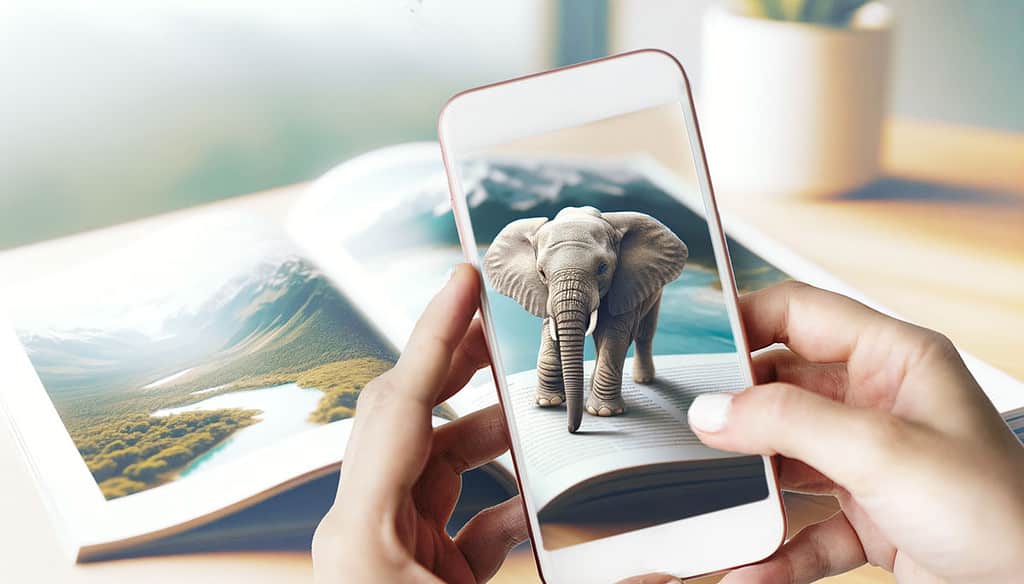

Print and poster advertising are among the oldest and most effective advertising formats that companies use to reach their target groups. But in an increasingly digital world, these traditional media face the challenge of competing with interactive and data-driven online campaigns. Augmented Reality (AR) offers an exciting solution here.
By integrating AR, print media and posters can be enriched with interactive content that not only appeals to customers visually, but also invites them to participate. Brands that use this technology create a bridge between the analog and digital worlds and make their advertising messages unforgettable.
Augmented reality in print and poster advertising means enhancing analog media with digital content. With the help of a Smartphones or tablets customers can use cameras and AR apps to discover additional information or interactive elements that are anchored on printed materials.
The technology is often based on marker-based trackingwhere special QR codes or visual markers on advertising can serve as a recognition and starting point for AR content. Other approaches, such as markerless tracking or GPS-supported posters, also offer exciting possibilities.
Publishers can use augmented reality markers or QR codes in their printed magazines, newspapers or print media of all kinds. When readers scan these with their smartphones, they can access additional content such as videos, image galleries, interactive infographics or exclusive articles. This no longer even requires an augmented reality app to be installed from an app store. This content can be accessed using the innovative WebAR technology directly in the browser. Real added value for your company and your customers thanks to AR technology.

Companies can use AR in printed advertising brochures and flyers to present their products or services in an interactive way. For example, customers could see product animations or immerse themselves in virtual worlds that represent the company.
Business people could add AR markers to their business cards that link directly to their website, social media profiles, or product presentations. This can create a memorable first encounter with potential customers.
to improve and enrich the shopping experience. By scanning QR codes or special AR markers in the catalogs, customers can unlock interactive content, such as 3D models of the products. This technology allows customers to view products from different angles as if they were right in front of them. For example, they can explore the texture, color and design of a product in much greater detail.
In addition, integrated videos with product demonstrations offer a further level of information transfer. These can show application possibilities, assembly instructions or various usage scenarios that go beyond the static images and text of a conventional catalog. Such interactive elements not only increase customer engagement, but also help them make an informed purchasing decision by giving them a more realistic picture of the product and its features.
AR in postcards and greeting cards offers a personal and modern dimension to communication. By integrating augmented reality, such cards can be enhanced with interactive elements such as animations or even video messages. Imagine receiving a birthday card that, when viewed through a smartphone, reveals a personalized video message or animation designed specifically for the recipient. This technology adds a new level of emotionality and surprise to traditional greeting cards. In addition, AR in postcards enables an innovative way of advertising or branding, where companies can deliver customized messages or promotional content in an original and memorable way. This not only creates a stronger emotional connection with the recipient, but also increases the likelihood that the message will be shared and spread further.
The "AR Cube" by Torsten Fell
PepsiCo used AR to link beverage cans with interactive games and videos. Customers could point their camera at the can and immediately unlock exclusive content.
IKEA catalog: Virtual furniture placement
The IKEA catalog combined printed pages with AR features that allowed customers to virtually place furniture in their rooms. This function was made accessible via the IKEA Place app and made the purchasing process much easier.
L'Oréal: Make-up trial via QR code
L'Oréal integrated QR codes into its print campaigns, giving customers direct access to virtual make-up samples. Users could try out lipsticks or eyeshadows in real time via an app and order them directly if they liked them.
1. increase interaction
AR adds an interactive dimension to static media. Customers can discover products from new perspectives, watch videos or interact with brand messages.
2. measurability of the campaign
AR can be used to make analog campaigns measurable. Companies can analyze how many users have scanned the QR code or interacted with the AR content.
3. integration of e-commerce
By linking to online stores or product pages, the path from interest to purchase is greatly shortened. Customers can order directly from the advertisement.
Design of interactive content
The design of AR content should be both creative and targeted. A clear call to action such as "Scan the code for more information" increases user participation.
Choose platform and tools
Companies should decide whether to rely on WebAR (directly in the browser) or app-based solutions. While WebAR is easier to access, apps often offer more extensive functions.
Consider technology and target group
The content must function smoothly on the target group's devices. It is therefore important to optimize AR applications for common smartphone models.
Technical barriers
Not all users are familiar with AR technology or have the necessary devices. Clear instructions and user-friendly interfaces help to overcome these hurdles.
Costs
The Development of high-quality AR content can be expensive. However, costs can be reduced by working with experienced agencies or using existing AR platforms.
Augmented reality gives print and poster advertising a new dimension. The technology combines analog and digital worlds, creates interactive experiences and enables an effective customer approach. Companies that integrate AR into their print campaigns can stand out from the crowd, anchor their messages sustainably and even facilitate the path to purchase.
AR is an indispensable tool for brands that want to enhance traditional advertising with state-of-the-art technology. It not only opens up new creative possibilities, but also makes traditional media fit for the future.
Integrating augmented reality into print marketing allows companies to engage their target audience in new and fun ways and enrich the customer experience, particularly through the use of 3D models that bridge the gap between the real world and digital innovations. These models can provide interactive elements that transform the static print product into a dynamic experience, opening up a world of possibilities. It also encourages customer loyalty and can help a brand to be remembered. However, it is important that the augmented reality experience, including the quality and relevance of the 3D models, is well implemented and offers real added value for the target group in their world so that it is not perceived as a mere gimmick.
As an augmented reality agency, we, at Design4real, can advise you extensively. We can create a customized AR solution for your print media.

Are you interested in developing a virtual reality or 360° application? You may still have questions about budget and implementation. Feel free to contact me.
I am looking forward to you
Clarence Dadson CEO Design4real






